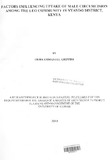| dc.description.abstract | Male circumcision has been carried out globally for many thousands of years, and is likely to be the most common surgical procedure, with an estimated 30% of men getting circumcised (UNAIDS, 2008). In many places circumcision has an important symbolic, cultural and religious meaning. For example, in certain communities of Eastern and Southern Africa young men are circumcised as a rite of passage that marks their transition from boyhood to manhood.
However, studies done on male circumcision by Auvert et al, (2006) ; Gray et al, (2007) and Bailey et al, (2007) indicate that the practice has potential of partially reducing HIV infection. This has led to increased advocacy among communities that were traditionally non- circumcising such as the Luo in Nyanza province resulting to high demand for male circumcision among men from this region. Apart from the above reason, no study has been conducted to determine other factors that influence uptake of male circumcision among men in non-circumcising communities.
The purpose of this study was therefore to investigate factors that influenced uptake of male circumcision (MC) among the Luo community in Nyando district in Kenya. Among the objectives that the study investigated included; determining the extent to which demographic factors influence uptake of male circumcision, investigating the socio-cultural factors that influence uptake of male circumcision among the Luo community in Nyando district and examining the relationship between perceived benefits of male circumcision and uptake of male circumcision among the Luo community in Nyando district.
The study employed descriptive survey design and the target population were mainly men aged between 15- 49 years. Multi-stage random sampling technique was used to sample a total of 128 men and 64 women at household level. 58 elderly people, MC mobilizers and providers were conveniently sampled. Data was organized and presented using both qualitative and quantitative methods and analyzed using SAS statistical package that applied Chi- square testing.
The study found out that demographic characteristics such as age, marital status and religion influenced uptake of male circumcision (MC) among the Luo community in Nyando. It also established that attitudes and perceptions are among socio- cultural factors that influenced uptake of Me. The study established that perceived benefits of male circumcision influenced uptake of male circumcision. From these findings, the study concluded that preference for male circumcision generally decreases with increase in age and that MC is more popular among the younger people. It was also concluded that socio-cultural factors and perceived benefits of male circumcision (MC) positively influence uptake of MC among men in Nyando district.
The study therefore recommended that more public awareness should be raised on the benefits of male circumcision especially to the elderly people in Nyando district. It also recommended that a model of male circumcision program be rolled out in Nyando district which involves a sensitization process in which men who undergo circumcision are taken through an informal training before undergoing circumcision. From the findings, the study suggested that future studies should focus on the sustainability of uptake of male circumcision in Nyando district. It has also recommended that future research should look at the risk compensation effect that is sparked by potential for increase in risky behaviour as a result of MC partially reducing HIV infection. | en_US |

